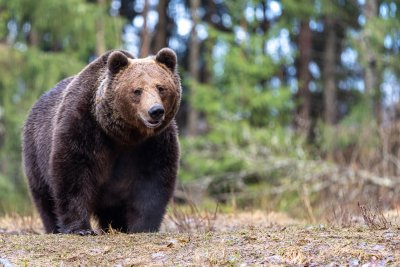News
Tracking genetic diversity - LOEWE-TBG scientists involved in population genomic study of brown bears

The brown bear is one of the largest land-dwelling carnivores in the world. Currently, there are about ten recognized subspecies distributed in North America, Europe, Russia and Asia, which differ in many characteristics and their way of life. An international research team, including Professor Dr. Axel Janke and Dr. Menno de Jong from the LOEWE Center for Translational Biodiversity Genomics (TBG) in Frankfurt am Main, Germany, has published the first population genomic study on the brown bear in the journal Communications Biology, which is part of the Nature journals. In doing so, they present the first comprehensive population genomic study on the brown bear (Ursus arctos) and use its example to show the effects of the last ice age on the current diversity within the species.
With the aim of verifying previous findings on similarities and differences between the various populations and answering open questions, the scientists compared the genomes of 128 brown bears from across the range. 95 of them were decoded especially for this study. Earth-historical developments and their effects on genomic traits were also considered.
"To get a comprehensive overview of brown bear population structure and genetic diversity, we examined and compared regions of the genomes with different inheritance traits, including X or Y chromosomes from female and male individuals. This gives us new, more sophisticated insights than analyzing the whole genome as a single unit. We found that the population structure resulting from our genetic data largely matches the current classification of subspecies - but not completely," explains Dr. Menno de Jong, lead author of the study and scientist at the Senckenberg Biodiversity and Climate Research Center and the LOEWE Center TBG.
In the process, the scientists also came across findings that can be traced back to geographical conditions during the last ice age. The Alaskan peninsula brown bear, for example, descends from the same ancestor as the Kamchatka bear. That's because the Russian Far East peninsula of Kamchatka and Alaska were connected about 11,000 years ago by the then-dry Bering Strait as a land bridge, providing opportunities for interbreeding.
"It seems utopian that we can glean these ancient migrations from genomic data to understand how the last Ice Age affected species. Previous methods and interpretations need to be reconsidered in light of the new findings," elaborates study leader Axel Janke, professor of comparative genomics at Senckenberg and Frankfurt's Goethe University and at the Hessian LOEWE Center TBG. "Genomic analyses of living organisms, such as we are doing at LOEWE-TBG, are revealing incredibly detailed new insights into the biodiversity of our planet and its evolutionary history. Genomics is only in its infancy, but it is already showing itself to be a future technology for fully understanding life," Janke continued.
The results of the study are important above all because they can serve as a template for a better understanding of the genomic diversity of many other species.

